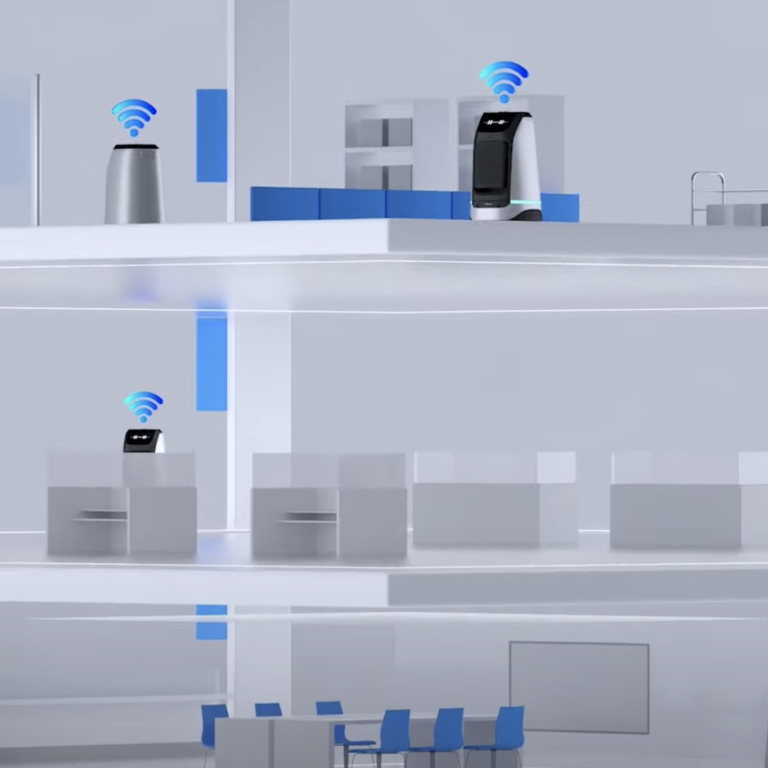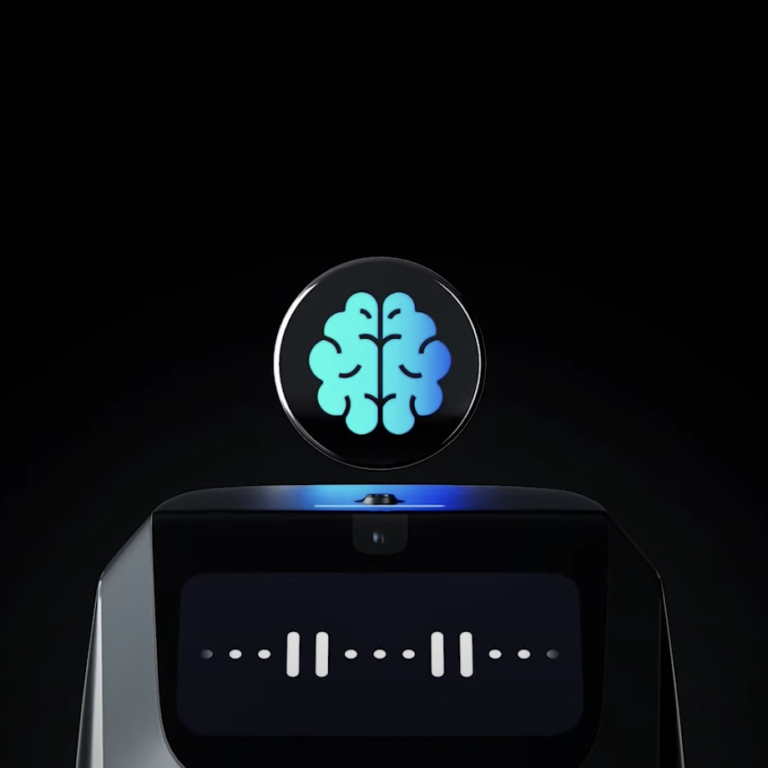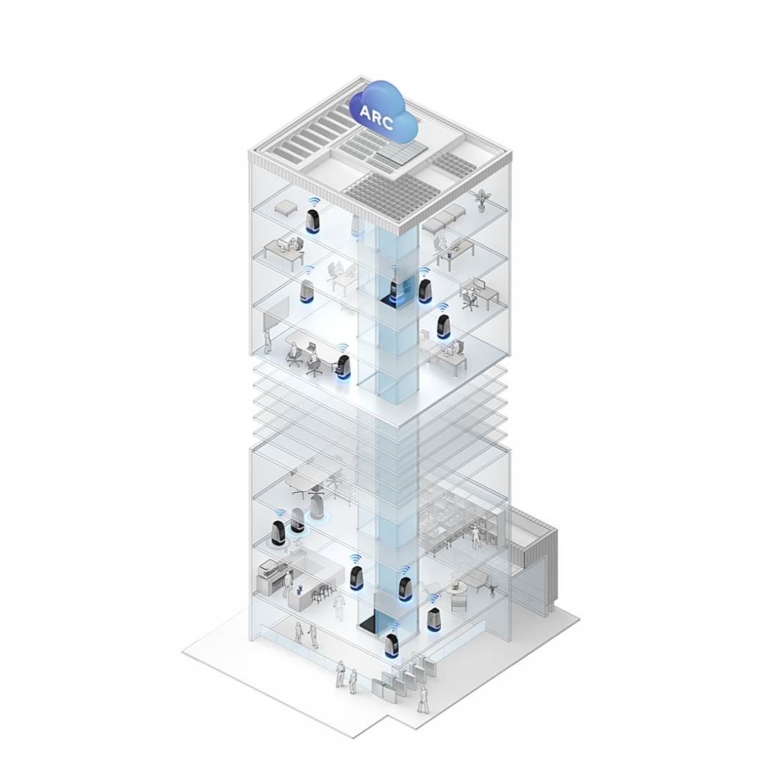5G Transformation Hub
Building a Private 5G network for Operation of Brainless Robots
Private 5G networks offer unmatched connectivity solutions
In NAVER 1784, multiple robots act as assistants for employees so that employees can focus on their work. These robots, called Rookie, are brainless as the brain functions are moved to the cloud and they need to exchange real-time information through 5G
Select a project
Contents
Challenge
In the initial stage of this project, when considering a communication method between the brainless robot and the cloud, Wi-Fi and mobile 5G networks from mobile carriers were reviewed. Wi-Fi was not a right option because it had handover issues. Mobile 5G networks also had limits since they are more focused on download, whereas upload is much more important for operation of the brainless robot. Thus, NAVER Cloud built a private 5G network and a cloud environment to provide reliable and real-time communication between the brainless robot and the cloud.
Solution
A network with high-speed data transfer between the robot and the cloud is critical to enable the brainless robot to operate seamlessly since the robot uses the cloud as its "brain." Accordingly, NAVER Cloud has decided to apply its own 5G network to the brainless robot project. This brainless robot has an advantage of enhancing its performance without installing the expensive computing power or sensors in its body, as it leverages information and carries out computations necessary for autonomous driving or other services through the cloud. In addition, numerous robots can be controlled by a central brain in the cloud simultaneously, and data uploaded on the cloud can be easily updated to the brains of other robots. So, the network facilitates large-scale production and operation of the robots.
Impact & Statistics
The Brainless Robot solution is still in a testing phase, and it is still difficult to present quantitative performance result from a business perspective. However, if the cloud-controlled and 5G-powered brainless robot is mass-produced, we can expect dramatic cost-saving effects compared to general robots. Updating a robot system itself in the could makes it possible to update a large number of robots all at once. Moreover, even if the number of robots increases, a reliable operation is viable with high-capacity computing power of the cloud.
Wider Implications
Now that NAVER Cloud has experience of building and operating private 5G networks, it now accelerates its effort to aim for commercialization of relevant packages and solutions in 2023. Though the package and solution have not been launched yet, they have already attracted the attention of many customers. To meet this demand, NAVER Cloud will try to commit to customers' business transformation by building and supplying their private 5G network to airports, logistics centers, hospitals, etc., that currently are limited to wired communications due to their large size.
Stakeholders
NAVER Cloud builds the private 5G network and provides the cloud infrastructure, NAVER LABS develops and manufactures the brainless robot
02
Private 5G Networks Enable Cloud-Controlled “Brainless” Robots
Private 5G networks offer unmatched connectivity solutions
In Korea, NAVER Cloud has built its own 5G network and cloud infrastructure to drive its “brainless” robot project at their headquarters building. This building is a tech convergence platform embodying NAVER's technological capabilities including robots, AI, cloud, and 5G, as well as a massive test bed for autonomous driving robots.
NAVER Cloud aimed to create an environment where brainless robots can coexist with human workers. The brainless robot has a system where positioning for its autonomous driving, as well as planning and processes to perform its tasks, are not made in its body, but rather in the NAVER Cloud Platform.
NAVER refers to this system as ARC, short for "AI, Robot, Cloud.” It determines the current position of the robot and suggests where to go next. All processing is done in the cloud instead of within the “brain” of the robot. Real-time communications between the ARC system and the brainless robot are key to enabling the robot's seamless autonomous driving and uninterrupted service performance.
When developing ARC, Wi-Fi was considered in the early stages of the project. However, there were issues with service reliability due to handovers. 5G networks from mobile carriers were also reviewed, but limits existed on operating the autonomous driving service robots because mobile 5G networks are more focused on download speed, whereas upload speed is more crucial for autonomous driving service robots.
So, NAVER Cloud determined to build its own private 5G network to run their brainless robots more effectively. The superior connectivity offered by the private 5G network allows the brainless robot to capture large numbers of images per second and upload them to the cloud. The cloud then processes the data received and sends out the next command to the robot. The high rate of data exchange required to enable autonomous driving is only possible with the power of a 5G private network.

03
Cloud-controlled “brainless” robots increase performance while lowering cost
A persistent challenge in robotics has been that the more advanced tasks the robot performs, the more computations the robot must process.
For tasks requiring precision, complicated algorithms and large amounts of data processing are required. To realize such tasks, the computing power embedded in the “brain” each robot had to be quite substantial, which thus incurred large costs.
NAVER Cloud’s “brainless” robots offer a new model. Since all complex processing is done in the cloud, no expensive computing or sensors are required in the body of the robots themselves. NAVER Cloud’s brainless robots are capable of high-performance autonomous driving using only cameras for positioning, basic sensors, and a small amount of compute power, drastically lowering costs. Furthermore, large numbers of robots can be controlled simultaneously by the central cloud, greatly easing operation.
The Brainless Robot Solution is still in a testing phase, and it is as yet difficult to present quantitative performance results from a business perspective. However, if such cloud-controlled, 5G-powered brainless robots were to be mass-produced, dramatic cost-saving effects compared to general robots could be expected.

04
The future of robotics is in the cloud
NAVER Cloud aims to operate 100 brainless robots at their headquarters by the end of 2022 and to commercialize the building of private 5G networks in 2023.
Brainless robots will be deployed at the "GAK Sejong", the to-be-built hyper-scale data center of NAVER. These robots are designed to support tasks in the data center such as server transfers, and local 5G networks for operating the robots are scheduled to be built before the end of 2023.
With the experience of building and operating the local 5G networks at their headquarters and GAK Sejong, NAVER Cloud will offer commercialization of their cloud-controlled brainless robot solution in 2023. Private 5G networks have not been launched yet but are already attracting the attention of many customers. Going forward, NAVER Cloud plans to build and deploy private 5G networks to airports, logistics centers, hospitals, and other locations that have typically been limited to wired communications due to their large sizes.
The unrivaled power of 5G private networks offer a massive leap forward in the computational power and affordability of robotics. A future awaits in which brainless robots, connected by the power of 5G and the cloud, could be deployed in a wide variety of environments and applications, changing the way we work and live.

05
About
About the GSMA
The GSMA is a global organisation unifying the mobile ecosystem to discover, develop
and deliver innovation foundational to positive business environments and societal
change. Our vision is to unlock the full power of connectivity so that people,
industry, and society thrive. Representing mobile operators and organisations across
the mobile ecosystem and adjacent industries, the GSMA delivers for its members
across three broad pillars: Connectivity for Good, Industry Services and Solutions, and
Outreach. This activity includes advancing policy, tackling today’s biggest societal
challenges, underpinning the technology and interoperability that make mobile work,
and providing the world’s largest platform to convene the mobile ecosystem at the
MWC and M360 series of events.
For more information, please visit the GSMA corporate website at
www.gsma.com.
Follow the GSMA on Twitter: @GSMA.
GSMA 5G Transformation Hub
The GSMA 5G Transformation Hub is a source of information on some of the most innovative 5G solutions in the world. This portal contains case studies detailing design, benefits, key players, measured value and the future impact of scaling up these 5G solutions worldwide. The 5G Era is now firmly established and this family of standardised GSM technologies, including mmWave, are being rolled out successfully across the globe. The GSMA 5G Transformation Hub, launched at MWC Barcelona in 2022, provides details of how 5G is best placed to deliver real value for a range of key sectors including manufacturing, energy, transportation, media and live entertainment, smart cities and construction.. Many more case studies will be added, in the coming months, covering even more industries and the GSMA is asking Members to nominate innovative 5G case studies to add to this global digital showcase. The 5G Transformation Hub and this particular Case Study are both sponsored by Qualcomm.
About this case study
This case study is for information only and is provided as is. The GSM Association makes no representations and gives no warranties or undertakings (express or implied) with respect to the study and does not accept any responsibility for , and hereby disclaims any liability for the accuracy or completeness or timeliness of the information contained in this document. Any use of the study is at the users own risk and the user assumes liability for any third party claims associated with such use.